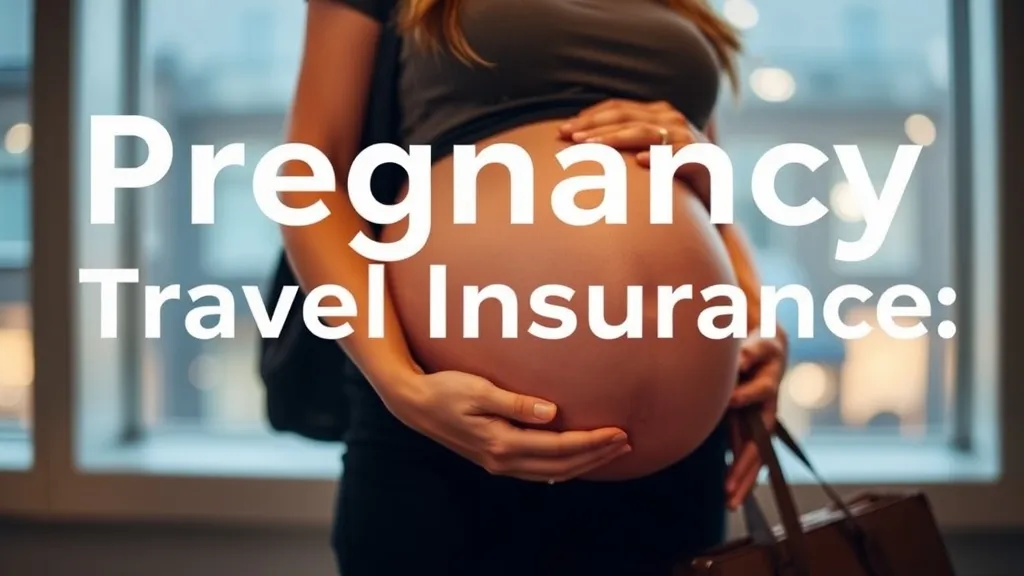Pregnancy Travel Insurance: A 2025 Guide
Traveling while pregnant can feel daunting. You want peace of mind on your babymoon but might worry about unexpected medical bills or trip cancellations. Our 2025 guide to pregnancy travel insurance lays out exactly what you need to know: what it covers, when to buy and how to get the best deal. In fact, about 20% of travel insurance claims were declined in 2023, per the FCA. Let’s dive in.
Table of Contents
What Is Pregnancy Travel Insurance?
Imagine this: you’re 24 weeks along, lounging on a beach, when contractions start. Without proper coverage, you could face thousands in out-of-pocket costs. Pregnancy travel insurance is a policy add-on or standalone plan that covers emergencies and complications related to pregnancy during your trip.
In other words, it extends beyond routine antenatal care. It kicks in for sudden complications like preterm labor or pregnancy-related hospital stays.
Real Example: Sarah, 30 weeks pregnant, booked a Mediterranean cruise. She added a specialized policy that covered emergency medevac after she developed preeclampsia. Without it, her airlift home would have cost $15,000.
“Pregnancy is not considered a pre-existing medical condition so you shouldn’t have to tell your insurer or pay more. However, check if antenatal care after premature births is covered, or cancellation due to pregnancy complications.”
— Dean Sobers, Which? insurance expert
Actionable Takeaway: Always verify that your policy covers pregnancy-related emergencies up to at least 28 weeks gestation.
Why You Need It for Your Babymoon
You might be wondering: “Why not rely on my health insurance?” Here’s the thing: domestic policies rarely pay overseas hospital bills or medevac flights.
A few key benefits:
- Emergency evacuation for preterm labor
- Trip cancellation if you develop complications
- Cover for antenatal issues like gestational diabetes flare-ups
- 24/7 access to medical hotlines
Case Study: Emma canceled her Florence getaway at 30 weeks when her doctor warned of early contractions. Her policy refunded $2,200 in prepaid expenses.
Actionable Takeaway: Treat pregnancy travel insurance as essential as your passport.
How It Works: Coverage, Limits, and Costs
Here’s the truth: policies vary widely. Understanding key components helps you avoid nasty surprises.
Coverage usually includes emergency medical treatment, repatriation, trip interruption and sometimes cancellation for pregnancy complications.
Typical limits:
- Medical emergency coverage up to $100,000–$500,000
- Cancellation/interruption reimbursements up to trip cost
- Emergency evacuation—often unlimited
According to Squaremouth, the average comprehensive travel insurance premium in 2025 is $311 for a 15-day trip (~$21 per day).
Example: At 26 weeks, Carlos and Mia opted for a plan with $250,000 medical coverage and a $1,000 cancellation clause—costing them $345 for a 12-day Caribbean cruise.
“Early purchase is vital. Buying insurance at booking time ensures coverage for almost any pregnancy-related issue that could arise before departure.”
— Industry report, 2025
Actionable Takeaway: Compare multiple quotes online and focus on total coverage limits rather than just premiums.
When to Buy: Timing Tips
Timing really matters. Buy too late and you risk missing out on full protection. Buy too early? You may pay a non-refundable premium you can’t use if plans change.
Best practice: Purchase immediately after booking your trip. That secures benefits like cancellation cover for unexpected pregnancy complications.
Example: Lily waited until 14 weeks; by 18 weeks, she needed to cancel due to hospitalization. Without cover purchased at booking, she lost $1,800.
Actionable Takeaway: Add insurance at the same time you pay your deposit.
Choosing the Right Policy: Key Features to Compare
Selecting a policy is like shopping for a baby stroller—you need the right fit and safety features.
Focus on these features:
- Maximum gestation covered (e.g., up to 28 weeks or beyond)
- Pregnancy complication add-ons (preterm labor, placental issues)
- Cancellation for maternal or fetal health emergencies
- 24/7 medical assistance availability
- Exclusions (routine antenatal visits usually not covered)
Real Example: A couple chose a customizable plan with a pregnancy complications rider—costing $70 more but adding $50,000 medical coverage explicitly for maternity emergencies.
“Digital quote tools now filter by pregnancy status, making comparisons faster and more accurate.”
— Lonely Planet Travel Insurance Guide, 2025
Actionable Takeaway: Use online comparison sites that let you declare pregnancy to find tailored quotes.
Beyond 28 Weeks: Special Considerations
After 28 weeks, policies often require medical certificates or exclude coverage entirely. High-risk pregnancies face even tighter restrictions.
If you’re past the typical cutoff:
- Request medical clearance from your doctor
- Look for insurers offering extended maternity coverage
- Consider a policy upgrade or specialized plan for high-risk pregnancies
Example: At 30 weeks, Priya secured an upgrade by submitting her clinician’s letter, adding $100,000 emergency coverage for $120 extra.
Actionable Takeaway: Always confirm gestation limits and document any medical approvals in writing.
FAQ
Q: Can I get travel insurance while pregnant past 28 weeks?
A: Yes, but most insurers require a medical certificate and may charge extra or limit coverage.
Q: Does pregnancy travel insurance cover routine antenatal care?
A: Generally no; it covers emergencies and complications, not standard check-ups.
Q: What’s a common exclusion in pregnancy policies?
A: Many plans exclude pre-existing conditions like hypertension unless you add a specialized rider.
Q: How much does a medevac flight cost?
A: Without insurance, a single emergency evacuation can exceed $20,000. With coverage, you’re usually covered in full.
Checklist Before You Buy
- Book insurance at trip deposit time
- Verify gestation cutoff and provisions for complications
- Review coverage limits for medical and evacuation
- Check cancellation and interruption terms
- Keep a copy of medical certificates if required
Conclusion
Pregnancy travel insurance transforms uncertainty into reassurance. You now know what it is, why it matters, how to secure the best coverage and when to act. Next steps:
- Compare tailored quotes immediately after booking.
- Confirm gestation cutoffs and document any medical approvals.
- Purchase a policy with robust emergency and cancellation cover.
With the right plan, you’ll focus on creating memories, not worrying about “what-ifs.” Here’s to a safe, stress-free babymoon with pregnancy travel insurance in 2025!





